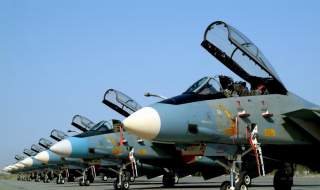Back in May One of Iran's Last F-14 Tomcats (Made in America) Crashed
And they don't have many left.
What happens next?
As reported by Scramble Facebook News Magazine, one of the few remaining Islamic Republic of Iran Air Force (IRIAF) F-14A Tomcats was involved in a crash at home base Esfahãn-Shahid Beheshti International Airport (Iran).
The IRIAF F-14A from the 8th Tactical Air Base crashed while it was landing. The aircraft reported an emergency to air traffic control during its training flight, subsequently the fighter was approved to make a quick landing at Esfahãn, but the aircraft was not able to hold position and skidded of the runway. Both pilot and Radar Intercept Officer (RIO) were forced to eject. They parachuted safely to mother earth.
The damage to the Tomcat is not known yet. Hopefully, pictures will become available soon.
It is said that the IRIAF only have some twelve to fourteen operational F-14A and F-14AMs left. The IRIAF faces large problems to keep their Tomcats in the air (the AM version is locally modified and equipped with new avionics and multi-function displays in the cockpit, countermeasure systems, radar warning receivers and an inertial navigation system).
Nevertheless, the iconic F-14 Tomcat remains the backbone of the Iranian interceptor fleet. As explained by Tom Cooper, Babak Taghvaee and Liam F. Devlin in their book IRIAF 2010: The Modern Iranian Air Force, due to the continuing lack of specific avionics components, the fleet of F-14s is divided into two categories: ‘parvazi’, meaning ‘airworthy’ but with no operational AN/AWG-9 radars and weapons systems; and ‘amaliyāti’, meaning ‘fully mission capable’, most of which have operational avionics and are considered capable of undertaking all types of air defense missions. The former aircraft are used for training of new pilots as well as for proficiency training, and have a secondary role as fighter-bombers equipped with general-purpose bombs and AIM-9 Sidewinder air-to-air missiles in the case of a war.
This first appeared in Aviation Geek Club here.

